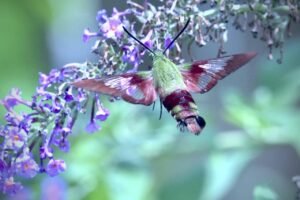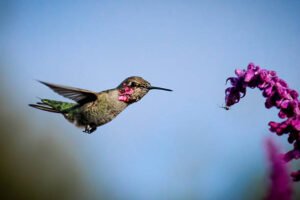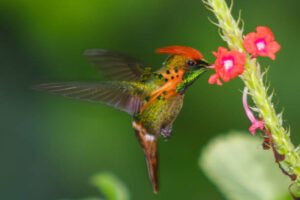
In the enchanting realm of avian wonders, few creatures captivate the imagination, like the hummingbird. Renowned for their dazzling iridescence, remarkable agility, and frenetic wingbeats, hummingbirds are a marvel to behold and boast a distinct culinary repertoire. This exploration unveils the delicate palate of these diminutive birds as we delve into the “5 Favorite Foods of Hummingbirds.” These charismatic creatures, belonging to the Trochilidae family, are not merely aerial acrobats but connoisseurs of nectar, insects, and floral ambrosia. Their dietary preferences reflect a harmonious relationship with their ecosystems, relying on specific foods to sustain their high-energy lifestyles.
The first on the list of hummingbird favorites is nectar, the sweet lifeblood of many flowering plants. These agile beings extract nectar with specialized bills and extendable, tube-like tongues, showcasing a symbiotic dance with the botanical world. Delving deeper, we explore the role of insects in the hummingbird’s diet. While nectar provides essential sugars, insects contribute vital proteins and nutrients, forming a balanced culinary medley for these feathered gourmands.
As we traverse the hummingbird’s gastronomic landscape, we encounter another favorite: tree sap. These aerial foragers tap into sap flows, relishing the sugary substance as a supplementary energy source. Additionally, our exploration unveils the significance of pollen and spiders in the hummingbird diet, shedding light on the intricacies of their nutritional requirements. In this journey through the gustatory delights of hummingbirds, we unravel the mysteries of their dietary preferences, offering a glimpse into the fascinating world where avian elegance meets the art of culinary survival. Join us as we embark on a winged odyssey to discover the five favorite foods that fuel the life and vitality of these dainty yet resilient aerial wonders.
Nectar
Nectar, the lifeblood of many flowering plants, is the primary elixir in the hummingbird’s culinary repertoire. In this expansive exploration, we venture into the intricate relationship between hummingbirds and nectar-producing flora, unveiling the physiological marvels that enable these agile aviators to extract and savor this ambrosial substance. At the heart of the hummingbird’s love affair with nectar lies a finely tuned adaptation of its bill. Shaped like a slender, elongated tube, the hummingbird’s bill is a specialized instrument crafted by evolution to access the hidden treasures within flowers. This ingenious design allows them to reach deep into floral cavities, accessing nectar reserves that elude less equipped competitors.

The process of nectar extraction is a balletic performance, a testament to the hummingbird’s aerial finesse. As they hover before a bloom, their wings beating at an astonishing rate of 50 to 80 flaps per second, the hummingbird delicately extends its bill into the flower’s recesses. The tongue, an intricate tube with a split, hair-like tip, unfurls into the nectar-rich chamber. Capillary action, aided by the elasticity of the language, draws the liquid upward like an ephemeral straw. This dynamic interaction between bill and tongue showcases the hummingbird’s evolutionary prowess and the seamless integration of form and function.
Beyond extraction mechanics, choosing floral partners is pivotal in the hummingbird’s dietary preferences. Certain flowers have explicitly evolved to attract hummingbirds, displaying vibrant hues and intricate shapes that align with the birds’ visual preferences. The coevolutionary dance between hummingbirds and these floral gems results in a mutualistic relationship. Hummingbirds receive sustenance, and plants benefit from cross-pollination as the birds transfer pollen from bloom to bloom.
The sweetness of nectar, primarily derived from sucrose, fructose, and glucose, fuels the hummingbird’s voracious metabolism. These simple sugars provide a rapid energy source, crucial for these tiny dynamos’ high-octane lifestyle. With their accelerated heart rates and demanding flight patterns, Hummingbirds rely on quickly converting nectar into energy, allowing them to sustain their astonishing aerial feats.
However, the quest for nectar has its challenges. Competition among hummingbirds for limited floral resources can intensify, leading to territorial skirmishes and dazzling mid-air displays. The availability of nectar is also influenced by environmental factors such as climate, altitude, and seasonal variations in floral bloom. Consequently, the hummingbird’s dependence on nectar demands adaptability, a trait that underscores their resilience in the face of ecological fluctuations.
Nectar stands as a foundational element in the hummingbird’s gastronomic symphony, representing a source of sustenance and a testament to the intricate dance of adaptation and coevolution. As we delve into the world of hummingbirds and their preferred food sources, the exploration of nectar unveils a narrative of precision, elegance, and the delicate interplay between these remarkable birds and the floral tapestry they call home.
Insects
Beyond the sweet embrace of nectar, hummingbirds reveal another dimension of their dietary prowess in the consumption of insects. This exploration segment delves into the intricate relationship between hummingbirds and the tiny, protein-rich creatures that share their aerial domain. From mid-air acrobatics to strategic hunting techniques, the hummingbird’s pursuit of insects adds a dynamic layer to their culinary repertoire.

Hummingbirds are not exclusively nectarivores but opportunistic omnivores that supplement their diet with various small invertebrates, mainly insects. This dietary diversity is crucial for meeting the hummingbird’s nutritional needs, providing essential proteins, fats, vitamins, and minerals that may be scarce or absent in nectar alone. The ability to switch between a predominantly nectar-based diet and insect consumption showcases the adaptability that defines these remarkable avian creatures.
The methods employed by hummingbirds in capturing insects are as varied as the insects themselves. Aerial hawking, a mesmerizing display of precision and agility, involves the hummingbird intercepting flying insects mid-flight. With exceptional maneuverability and lightning-fast reflexes, hummingbirds snatch their airborne prey with astonishing accuracy. This behavior is a testament to their hunting prowess and a visual spectacle that highlights the intersection of nature’s most skilled aerial performers.
Ground foraging represents another facet of the hummingbird’s insectivorous activities. While perched or hovering near the ground, hummingbirds scan the vegetation for small insects and spiders. Their keen eyesight and rapid, darting movements enable them to snatch unsuspecting prey from leaves and branches, showcasing a versatility that extends beyond the realms of the aerial ballet for which they are renowned.
One of the critical insect groups in the hummingbird’s diet includes spiders. Despite the arachnids being a departure from the typical image of insect prey, hummingbirds are known to seek out and consume spiders for their protein content. This behavior has led to an intriguing ecological interplay, as hummingbirds inadvertently contribute to pest control by curbing spider populations in their foraging territories.
Including insects in the hummingbird diet is not solely driven by nutritional necessity; it also reflects a nuanced ecological balance. By consuming insects, hummingbirds inadvertently contribute to pollinating flowers and controlling insect populations, playing a role in the intricate tapestry of ecosystem dynamics. This multifaceted relationship exemplifies the interconnectedness of species within their environments, emphasizing the hummingbird’s significance beyond its aesthetic appeal.
The hummingbird’s incorporating insects into its diet unveils a dimension of its dietary habits extending beyond the floral realm. From mid-air pursuits to ground-level foraging, these avian marvels showcase diverse hunting techniques, underlining their adaptability and resourcefulness in securing the nutrients essential for their survival. As we continue exploring the hummingbird’s culinary world, including insects, it adds a layer of complexity and ecological significance to their remarkable dietary strategy.
Spiders
In the intricate web of the hummingbird’s dietary choices, one unexpected thread emerges: spiders. These tiny arachnids, often associated with traps and stealthy ambushing, play a unique role in the hummingbird’s culinary repertoire. As we unravel the complexities of this unlikely relationship, we discover the nuances of hummingbirds actively seeking out and consuming spiders, elevating their diet beyond the realms of floral nectar and insects.

Hummingbirds, primarily recognized for their prowess in nectar extraction and aerial insect pursuits, are surprisingly inclined to spiders as a dietary supplement. While nectar and insects provide essential sugars and proteins, spiders contribute a different nutritional profile rich in fats and additional proteins. Including spiders in their diet showcases the hummingbird’s adaptability, as they selectively diversify their food sources to meet the demands of their high-energy lifestyle.
The hunting strategy employed by hummingbirds when targeting spiders is a captivating display of precision and skill. Using their sharp bills, hummingbirds delicately pluck spiders from their webs or capture them hiding among leaves. This requires a fine-tuned coordination of beak and eye as hummingbirds navigate the complex structures of spider silk to secure their prey. The process is a testament to their foraging abilities and an illustration of the hummingbird’s ability to exploit diverse food sources in their environment.
The significance of spiders in the hummingbird’s diet extends beyond mere nutritional content. Hummingbirds inadvertently contribute to pest control as they consume spiders, influencing the delicate balance of insect populations within their ecosystems. This ecological role adds a layer of complexity to the hummingbird’s foraging activities, positioning them as integral players in maintaining the health and equilibrium of their natural habitats.
The relationship between hummingbirds and spiders also introduces intriguing questions about coevolution and mutual benefits. While hummingbirds secure a valuable protein source, spiders may experience a reduction in potential insect predators, given the hummingbird’s active role in controlling insect populations. This interdependence emphasizes the interconnectedness of species within ecosystems and underscores the subtle ways in which seemingly disparate organisms can influence each other’s survival strategies.
As we peer into the hummingbird’s world, including spiders in their diet unveils a lesser-known chapter in their foraging adventures. It adds a layer of complexity to our understanding of their dietary habits, showcasing a strategic and adaptive approach to securing the diverse nutrients necessary for their survival. In the grand tapestry of nature, where every species plays a unique role, the hummingbird’s choice to include spiders in its menu exemplifies the intricate dance of life and the interwoven relationships that shape the ecology of their habitats.
Tree sap
Amidst the blossoms and the aerial ballet, hummingbirds unveil yet another facet of their eclectic diet: the indulgence in tree sap. In this exploration, we venture into the unexpected realm of sap-feeding behavior, understanding how these diminutive avian wonders tap into the sugary tree sustenance. From the adaptation of specialized feeding techniques to the ecological implications of this dietary choice, the consumption of tree sap unveils a captivating chapter in the hummingbird’s culinary story.

Unlike nectar, extracted from flowers, insects, and spiders captured mid-air or foraged from vegetation, tree sap represents a distinct source of sweetness for hummingbirds. This behavior is not uniform across all hummingbird species, but specific individuals have been observed displaying sap-feeding tendencies, showcasing the versatility and adaptability inherent in their foraging strategies.
The process of sap-feeding involves hummingbirds perching on tree branches or trunks, probing the bark with their bills to access the sap seeping from wounds or naturally occurring pores. Some species have developed specialized statements with serrated edges or modified tips, allowing them to pierce tree bark more efficiently. As they access the sap, hummingbirds extract not only sugars but also additional nutrients, expanding the nutritional diversity of their diet.
The choice to consume tree sap is not arbitrary; it is deeply intertwined with the hummingbird’s need for a well-rounded nutritional profile. While nectar provides essential sugars and insects contribute proteins, sap offers a different spectrum of carbohydrates and minerals. This diversity is particularly crucial for hummingbirds living in environments where floral resources may be scarce or face competition for nectar from other bird species.
The relationship between hummingbirds and trees becomes a harmonious dance as these agile birds capitalize on the sap flow, a resource that might otherwise go unnoticed. Some hummingbird species have developed a remarkable ability to detect changes in sap flow, allowing them to navigate vast territories in search of these sweet oases within the arboreal landscape. This attunement to their environment underscores the finely tuned adaptations that have evolved in hummingbirds over millennia.
From an ecological standpoint, hummingbirds’ consumption of tree sap introduces a fascinating dimension to their role in forest ecosystems. Beyond their more commonly recognized pollination services, hummingbirds engaged in sap-feeding contribute to nutrient cycling within the forest. By tapping into tree sap, hummingbirds play a subtle yet significant role in the intricate balance of energy flow within their habitats.
Including tree sap in the hummingbird’s diet enriches our understanding of their foraging versatility. This unexpected dietary choice adds a layer of complexity to their culinary preferences, revealing the nuanced ways hummingbirds adapt to their surroundings and optimize their nutritional intake. As we continue to explore the multifaceted world of hummingbirds, the sweet sip of tree sap emerges as a unique and delightful note in their gastronomic symphony.
Pollen
In the intricate tapestry of the hummingbird’s culinary choices, pollen is a crucial and often overlooked component. This exploration delves into the significance of pollen in the hummingbird’s diet, shedding light on how these tiny avian marvels actively seek out and consume this floral treasure. From the nutritional benefits to the ecological implications, including pollen in the hummingbird’s menu adds a vibrant and essential hue to their gastronomic symphony.

Pollen, typically associated with the reproductive cycles of flowering plants, holds a unique allure for hummingbirds seeking a well-rounded and nutritious diet. While nectar remains the primary source of sugars, and insects and spiders contribute proteins and fats, respectively, pollen introduces a spectrum of nutrients that further enriches the hummingbird’s nutritional intake. These include essential amino acids, lipids, vitamins, and minerals, making pollen a valuable supplement to their dietary repertoire.
The process of pollen consumption is intricately tied to the hummingbird’s foraging behaviors. Unlike bees, who collect pollen for their protein-rich diet, hummingbirds inadvertently gather it while feeding on nectar. As they extend their bills into flowers to access the sweet nectar, their heads come into contact with the flower’s anthers, collecting pollen on their accounts and charges. The hummingbird’s frequent visits to various flowers contribute to cross-pollination, inadvertently aiding in the reproductive success of the plants.
The nutritional content of pollen serves as more than just a supplement; it addresses specific dietary needs that might be lacking in other food sources. For instance, the lipids in pollen provide hummingbirds with essential fatty acids crucial for energy metabolism and overall health. Additionally, the amino acids found in pollen contribute to the hummingbird’s protein requirements, complementing the protein derived from their insect and spider prey.
Pollen consumption is not uniform across all hummingbird species. Some exhibit a greater affinity for pollen, actively seeking out flowers with anthers and engaging in behaviors that maximize pollen transfer. This variability underscores the adaptability of hummingbirds, allowing them to tailor their foraging strategies based on the nutritional composition of available resources.
Beyond the nutritional advantages, including pollen in the hummingbird’s diet has broader ecological implications. Hummingbirds, unwittingly acting as pollinators, contribute to the reproductive success of numerous plant species. This mutualistic relationship underscores the intricate balance between flora and fauna in their ecosystems. As hummingbirds move from flower to flower, they facilitate genetic diversity in plant populations, ensuring the resilience and adaptability of the floral community.
Pollen stands as a floral powerhouse in the hummingbird’s nutritional ensemble. Its inclusion in their diet represents a sophisticated adaptation beyond mere sustenance, contributing to their overall health and inadvertently supporting the reproductive cycles of the plant species they visit. As we unravel the intricacies of the hummingbird’s foraging habits, pollen emerges as a vital and harmonious note in their gastronomic symphony, revealing the interconnected dance between these tiny aerial wonders and the flowering world they so gracefully inhabit.
Conclusion
The hummingbird’s culinary journey unfolds as a symphony of adaptation and diversity in the enchanting realm of avian wonders. From the sweet embrace of nectar to the agile pursuit of insects and the unexpected indulgence in tree sap, the hummingbird’s eclectic diet showcases its remarkable versatility. Spiders and the surprising pollen consumption add intricate layers to their gastronomic repertoire, revealing nutritional acumen and ecological significance.
With their specialized bills and aerial finesse, these tiny avian marvels navigate a complex tapestry of dietary choices that extend beyond mere survival. Their foraging behaviors sustain their high-energy lifestyles and contribute to the delicate balance of their ecosystems, showcasing the hummingbird as a critical player in the interconnected dance of nature, a testament to the beauty and resilience of these charismatic aviators in the intricate web of life.





